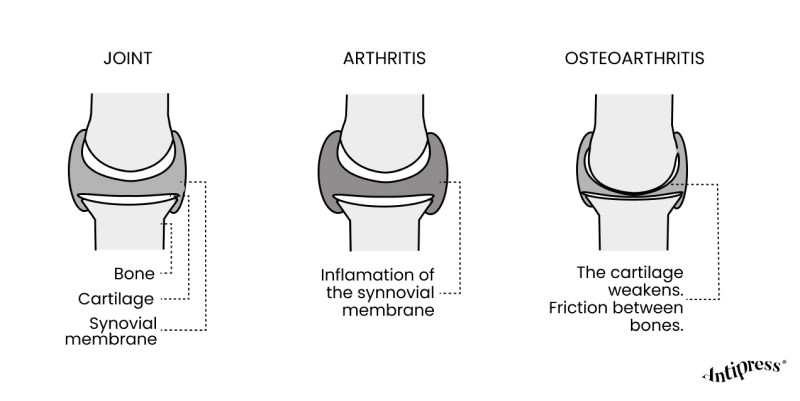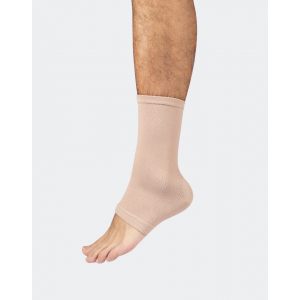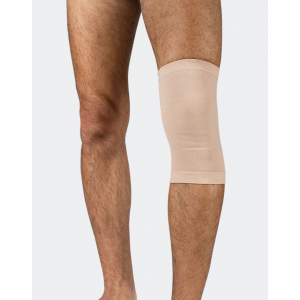Differences between Arthritis and Osteoarthritis


We explain you how both diseases are distinguished in terms of symptoms, diagnoses and treatments.
Many people talk about arthritis and osteoarthritis as a single disease. The reality is that both affect the joints. But neither the causes nor the diagnosis nor the treatment are the same. In this post, you will learn to differentiate arthritis from osteoarthritis.
Similarities Between Osteoarthritis and Arthritis
Both arthritis and osteoarthritis are diseases that affect the joints. In addition, some symptoms are often similar, causing joint pain, stiffness, swelling and redness. Both conditions are not curable, but early treatment can slow the worsening. Both ailments are more common in women than in men.
Differences between Osteoarthritis and Arthritis
Understanding where both diseases differ is necessary to understand each situation better. In fact, the two terms share the same root (artr, from the Greek articulation), but the suffixes have different meanings (-osis means wear while -itis refers to inflammation).
Osteoarthritis is a disease that consists of the wear of the joint cartilage, which is the tissue that covers the bones so that there is smooth movement and little friction. As the years go by, this cartilage weakens and can eventually disappear, allowing the bones to rub against each other and causing pain.
Instead, arthritis is an inflammation of the synovial membrane, an elastic tissue inside the joints that reduces friction between the cartilage and other joint structures. When someone has arthritis, their synovial fluid spreads throughout the joint and their bones and cartilage erode.


When it comes to the location of the pain, osteoarthritis usually appears in the cervical and lumbar spine, in the hands, in the hips and in the knees. In contrast, arthritis is not common in the spine and, in addition to the knees and hands, it also usually occurs in the feet.
Pain manifests itself differently. In the case of osteoarthritis, pain is more noticeable when the joint is moved, but it improves when it is left at rest. However, in arthritis the pain is much more constant and does not improve at rest. In fact, some types of arthritis can be accompanied by fever and tiredness.
As for the diagnosis, osteoarthritis is usually detected by a physical and radiological examination by the doctor. But in arthritis, no specific tests and fluid analysis from the affected joint or blood tests are often required.
Arthritis is common in people between the ages of 20 and 40, although it can occur at any time. It can be due to infections by germs, trauma or other ailments. In contrast, osteoarthritis usually occurs in people over 40 years of age and is associated with ageing.
The treatments are also different. Arthritis's main methods are anti-inflammatories, while in osteoarthritis physical exercise is prioritized. Not being a curable disease, osteoarthritis requires patients not to follow a sedentary lifestyle in order to avoid obesity. You have to move to reduce the pain. Analgesics or anti-inflammatories are also recommended to treat the pain.
There are supports for immobilizing the joint to reduce pain and to be able to move more easily. At Antipress we offer knee and ankle braces for osteoarthritis and arthritis made without seams, adaptable and without wrinkles with a totally local design and production.
Types of arthritis
Unlike osteoarthritis, dozens of varieties of arthritis have been detected, which have different causes and treatments. The most frequent are the following:
- Osteoarthritis: It usually appears in the hip joints, spine, hands and knees. It is about the wear and tear of the cartilage.
- Juvenile arthritis: Affects children and their joints. It can damage internal organs.
- Psoriatic arthritis: Affects the joints of people suffering from psoriasis, a skin disease.
- Infectious arthritis: Loss of movement is caused by a bacterial or fungal infection.
- Gout: It is due to excess uric acid in the blood. It accumulates in the synovial membrane of the joints, causing pain, swelling and a lot of stiffness.
- Autoimmune arthritis: Antibodies are what destroy tissues and cause this inflammatory disease. Very common on the fingers and wrists.
References:
- https://www.bbc.com/mundo/noticias-42512083
- https://www.kernpharma.com/es/blog/artritis-y-artrosis-conoce-las-diferencias
- https://www.infosalus.com/salud-investigacion/noticia-conocer-diferencias-semejanzas-artrosis-artritis-puede-ayudar-mejorar-prevencion-20140316121650.html





